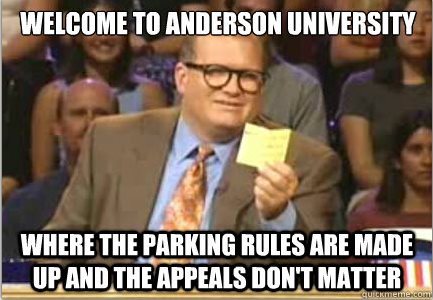First off, if you don't know what a meme is, feel free to indulge and acquaint yourself
here. A late Friday afternoon before Spring Break a friend and I created a Facebook fan page for humorous
Anderson University-related memes called the
Anderson University Meme Page.
Within a matter of 72 hours this page exploded. We originally created it as an inside joke for a few friends. I invited solely about 20 people to the page thinking they would find the content humorous, but the effect was dramatic. The page had over 500 likes, over 150 postings on its wall, and thousands of individual likes on different postings all within a matter of 3 days. Now the page is over 700 likes. This may not seem necessarily “dramatic,” but with a student body of a little over 2000, we were looking at almost 35% of the AU student body “liking” and being involved on this page (assuming all likes were from AU students and all students have profiles on Facebook). We had essentially created the
newest trend on Anderson University’s campus.
Why, though, did this explode so quickly? How did we reach 35% of our entire “target market” in a matter of 72 hours? And the question everyone is dying to know: will this trend stay popular or die out?
Here are four reasons why Anderson University Meme’s worked:
1. User-Generated Content.
Anderson University Memes is almost entirely composed of user-generated content. Students create the content and upload it to the Facebook page. They pour their own blood, sweat, and tears into their creations, so of course they’re going to come back, share, and invest time in the page itself. User-generated content gets people engaged on your site. It gives “customers” or fans a personal connection to your brand. With user-generated content, we now have over 700 different minds thinking of new content and jokes to make on our site.
2. Funny sells.
In the past decade or so, many companies and firms have been using sex to sell products. I believe recently, though, this has become less prevalent. The general public does not care so much anymore for sparsely dressed women anymore. What really does “sell,” though, is funny. People love to laugh. “What soap is to the body, laughter is to the soul.” Laughter is a necessity in life. It always puts people in a better mood. Why do people like the Super Bowl Commercials? They are hilarious.
3. Competition.
Everybody likes some good old-fashioned competition. In order for your meme to stay on the page it had to receive a certain amount of likes in a given time period, allowing the public to decide what was funny and what was not. Competition draws customers in. It allows them to connect with the brand and take ownership. The competition also keeps them coming back. It also gives them bragging rights on their own personal meme.
4. Common Experiences
The page quickly created a community around it. We all shared the same experiences with Anderson University and understand the inside jokes. The common experience creates a community—something marketers and branding people try their whole career to create. It keeps people engaged and entices people. That’s why they find it funny. That’s why they come back. That’s why they enjoy the page and that’s why it worked. The initial explosion has quieted down and not many people are using it still, but good, new memes still average high like percentages. It will be interesting to see if it was just a short-lived fad or if it will continue on.

